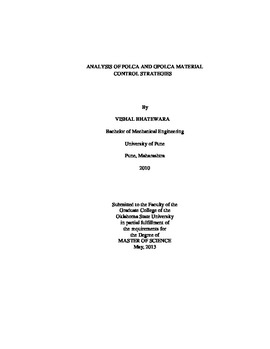| dc.contributor.advisor | Kamath, Manjunath | |
| dc.contributor.author | Bhatewara, Vishal Gautamchand | |
| dc.date.accessioned | 2014-09-24T14:17:55Z | |
| dc.date.available | 2014-09-24T14:17:55Z | |
| dc.date.issued | 2013-05-01 | |
| dc.identifier.uri | https://hdl.handle.net/11244/11068 | |
| dc.description.abstract | Scope and method of study: This research sheds new light on the performance of two relatively new material control strategies, known as Paired-cell Overlapping Loops of Cards with Authorization (POLCA) and Generic-POLCA (GPOLCA). POLCA and GPOLCA are designed for use in high variety/low volume manufacturing environments and were introduced in 1998 and 2006 respectively. So far, very few studies have been published comparing the performance of these two material control strategies and these have not considered practical shop floor conditions, which exist in a high variety manufacturing environment. The focus of this study was on analyzing the performance of POLCA and GPOLCA material control strategies for different manufacturing settings using simulation and design of experiments approach. Statistical analysis of the simulation results was used to compare the two strategies and provide new insight into their performance.Findings and Conclusions: A new method of calculating the number of GPOLCA cards was developed instead of the previous method of random search for finding out number of cards. Also, a heuristic approach for setting up the POLCA and GPOLCA material control strategies was introduced and it was shown to be good alternative to the current iterative method of setting up these two strategies. Our study supports and confirms the previous comparison studies, which say that GPOLCA requires less WIP on the shop floor compared to POLCA to achieve the same throughput. At the same time, we have some new findings, which reveal that GPOLCA requires a higher total inventory and longer response time as compared to POLCA to achieve the same service level. Moreover, because of the incorrect prioritization of the orders, GPOLCA increases the average tardiness and total inventory of a product that needs a higher number of operations on the shop floor. Thus this research has uncovered a drawback of the GPOLCA material control strategy and showed the importance of proper prioritization of the orders in a high variety manufacturing environment. | |
| dc.format | application/pdf | |
| dc.language | en_US | |
| dc.publisher | Oklahoma State University | |
| dc.rights | Copyright is held by the author who has granted the Oklahoma State University Library the non-exclusive right to share this material in its institutional repository. Contact Digital Library Services at lib-dls@okstate.edu or 405-744-9161 for the permission policy on the use, reproduction or distribution of this material. | |
| dc.title | Analysis of Polca and Gpolca Material Control Strategies | |
| dc.type | text | |
| dc.contributor.committeeMember | Pratt, David | |
| dc.contributor.committeeMember | Liu, Tieming | |
| osu.filename | Bhatewara_okstate_0664M_12761.pdf | |
| osu.accesstype | Open Access | |
| dc.description.department | Industrial Engineering & Management | |
| dc.type.genre | Thesis | |
